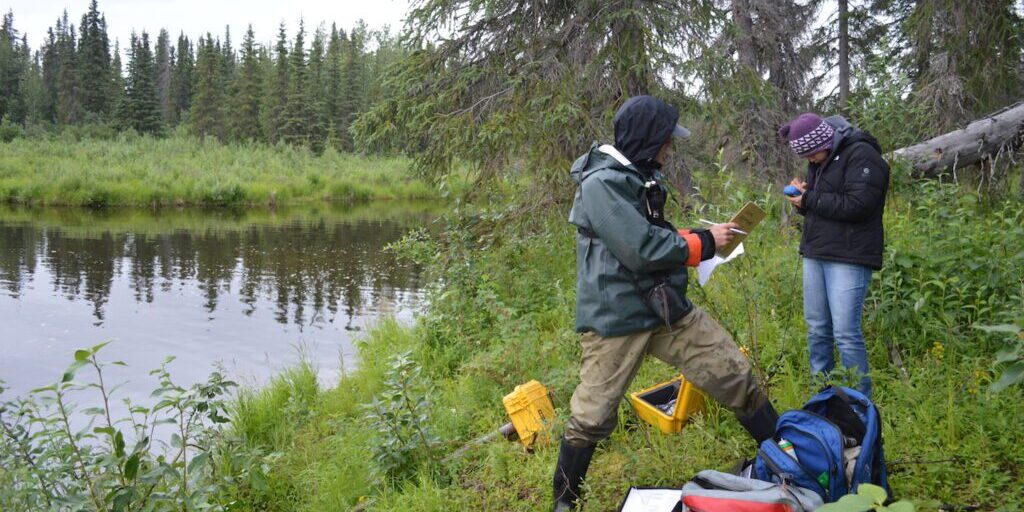FORTY miles from Elim up the Tubuktulik River, a small gauge sits at the water’s edge, just downstream from the state-owned Boulder Creek site—the largest known uranium deposit in Alaska, and a hot spot for potential mining.
At the base of the gauge, a level troll device pulls temperature and depth recordings every 15 minutes from the bed of the river. The device is there because residents of Elim don’t want to see mining develop near the Tubuktulik. During the 2008 Iditarod race, students and elders rallied at the Elim checkpoint to protest Triex Minerals Corporation, the Canadian mineral exploration company that was exploring the uranium deposit near Boulder Creek in 2006. Now, they’re hoping to get official protection.
Hal Shepherd is the director of the Center for Water Advocacy, and has been working with Elim’s Tribal Council on a data collection plan for the Tubuktulik River. He and Leigh Takak, a field technician for the watershed program, have been boating up the river almost every month for the past two years. Their destination—the testing site—is one of the only spots on the Seward Peninsula with a gauge device that’s constantly collecting data. Grants from the Norton Sound Economic Development Corporation and the Bureau of Indian Affairs fund the fuel and testing equipment needed for the data collection project.
Last week, Shepherd and Takak conducted their routine testing at the site.
“First, we used an instrument called a level troll to test depth and temperature. And then we did the transect, so we measured the discharge along that long transect that was about 120 feet wide or so,” said Shepherd. “Then we measured water quality, because that is a concern about any type of mining activity—particularly uranium—that could contaminate the water source.”
Shepherd said these tests yield baseline data for the health of the river—data that will be turned over to the state of Alaska as part of Elim’s in-stream flow reservation application. If granted, Mayor Tyler Ivanoff said, the reservation would grant Elim jurisdiction over the water flowing into their land.
“If we attain them, we would be able to stop mining companies from using the water which would flow into our area,” said Ivanoff. “If we don’t get those water rights, then the state or the other mining companies can just use our water and probably pollute our rivers that we’ve been fishing on since time immemorial.”
Alaska is one of few states in the country to allow for individuals, in addition to state, federal and local governing agencies, to apply for reservations of state-owned water. However, Ivanoff said, the state doesn’t hand out these reservations frequently—and the application itself is a large undertaking. You need five years of data to be granted a reservation, though the application can be submitted after two years of data collection.
Shepherd said Elim anticipates submitting their application this fall. But until then, and for the next three years, he’ll continue making the 10-12 hour trip up the Tubuktulik. He said it’s a journey ripe with challenges—and, of course, the occasional pit stop for fishing on this healthy river.
“It’s so difficult to get up here. It’s so remote. The logistics are almost mind-boggling. You know, a lot of people are really excited about collecting good data. We get excited if we can just get to the gauge,” said Shepherd. “And we do it in the winter time, too. We do ice flow measurements. You have to come up by snow mobile. It can be pretty dicey trying to get up here in the winter.”
Though the trip isn’t easy and chances of actually securing a water reservation are uncertain, Elim Water Advocate Emily Murray believes this work is worthwhile. Murray is working with Shepherd on applying for the reservation. Last year she was a strong voice against HB77, a state bill that would have prohibited applications for in-stream water reservations like the one Elim is currently working towards.
“We need to be at the table, we need to be part of the permitting process, we really need to be. Because you know [the mining companies] could come and go but we’re still going be here. It’s that much more important for us to fight for our clean water in our backyard,” said Murray. “You know, you need to exercise your authority in that area.”
Even if Triex Minerals Corporation does not pursue a mining operation along the Tubuktulik River—with the price of uranium now down to $30 per pound, less than half its trading price in 2006—the community of Elim is continuing to take precautionary action.







